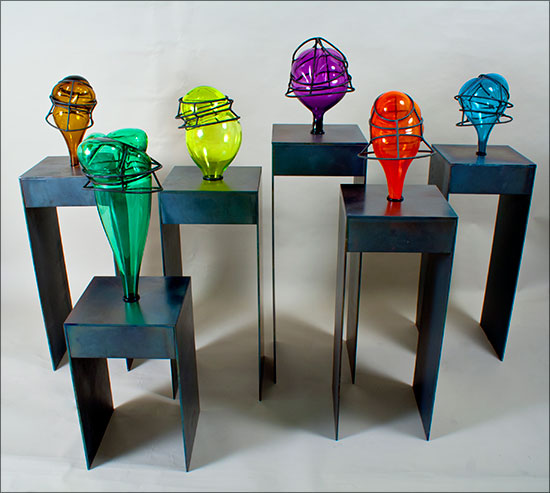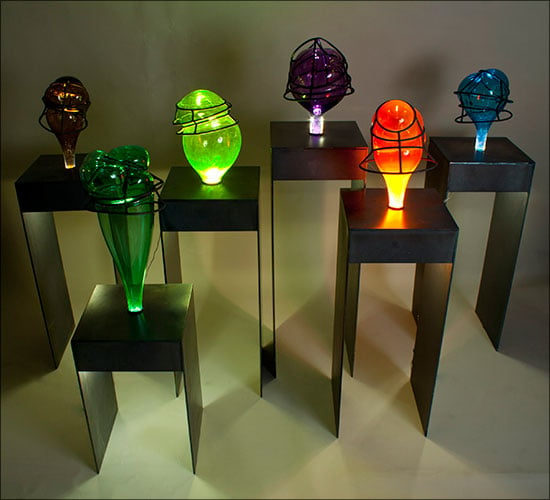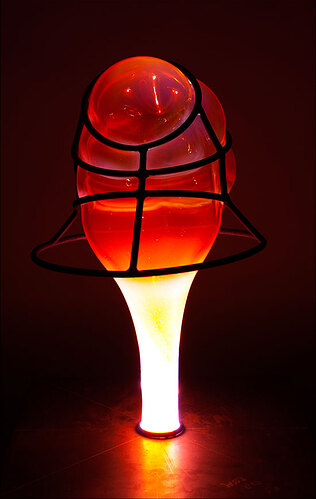Materials: Steel, Glass, LED Lights
Dimensions: 12x48x12"
Welded steel girdles; blown glass.
Photo credit: Eric Roman Beining
KT Hancock
Milwaukee, WI. USA
“Series: Some Kind of Nature,” investigates organic forms relative to mycology. When referencing the scientific processes of fungal specimen, one may witness the absorption of nutrients and consequentially a dispersal of organic material. The forms found within these specimen are analogous to the forms within the series as a more narrow stem leads to a round, bulbous top. Examining the russula genus of fungal specimen, one may relate the body of work to brittle, and fragile phenomena within nature.
This series was created as a commentary on the juxtaposition between fragility and strength in nature. The steel girdles emulate an exoskeleton, restricting the movement of the fluid glass within. The spherical nature of the blown glass bubble is distorted and manipulated by the steel girdles they are blown within. The glass succumbs only partially to the steel structures, breaking through the negative spaces and pillowing outward.
Drawing attention to its transparent medium, the glass is illuminated by LED lights. This highlights the concave and convex forms and brings life back into the study.
These containers and vessels definitely hold their place in the world of stunning art objects as well as in the world of metalsmithing.
Since the dawn of time humans have created containers to hold things that were important to them, from large vessels to hold food and harvests to intimate containers for small precious things. They might hold memories, ashes, medicine, beverage, fruit or food - but all spring from the imagination and skill of the maker. Some have specific religious functions, some are meant for everyday use. When one thinks of a vessel or container the inclination is to think of something with solid walls - yet many of these works involve the exploration of positive and negative space, and the use of negative space to help create the illusion of the wall of the vessel.
As the world’s largest jewelry related internet site, Ganoksin strives to develop exhibitions showcasing work from around the world. This exhibition was open to all metalsmiths, professional and amateur, advanced and beginner. Participants are from The Netherlands, the USA, Canada, Australia, Costa Rica, the United Kingdom, Israel, Hong Kong, Colombia, Romania, Italy, Ireland, Japan, Malaysia and Denmark. While most of the pieces are by an individual metalsmith, some are collaborations, one of three artists spanning 50 years.
In total 319 artists contributed 729 show pieces for the permanent online exhibition.
Objects in the exhibition include boxes, lockets, urns, ash containers, bowls, wine cups, reliquaries, match holders, vases, teapots, pitchers, sugar bowls, baskets, nests, pillboxes, clutches and a range of sculptural forms. A variety of techniques are showcased covering a wide range of metalsmithing techniques. Materials used include everything from gold and silver to less expensive metals. Ornamentation includes the addition of enamel, chasing and repousse’, gemstones and found objects.
The exhibition was curated by Beth Wicker, President of the North Carolina Society of Goldsmiths in the United States, and Adjunct Instructor at Northeastern Technical College in South Carolina. Director of the exhibition is Hanuman Aspler, founder of The Ganoksin Project, the world’s largest internet jewelry site.

Note From Ganoksin Staff:
Looking for a led work light for your jewelry projects? We recommend:
- Reading our guide to the Best Led Work Lights Review for jewelry work here
- Searching for more discussions about Jeweler’s Torches here on the Orchid forum

